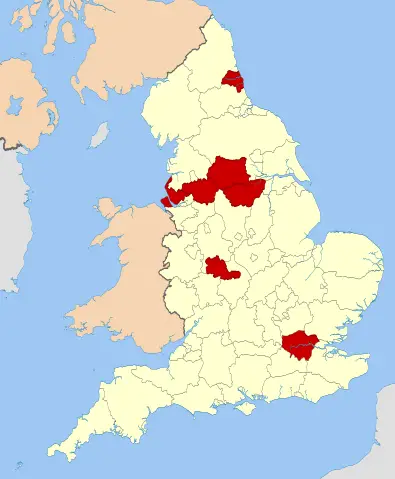Counties are larger administrative divisions, while districts are smaller subdivisions within counties, often used for local governance or planning.
In the United States, counties and districts are both forms of local government, but they serve different purposes and have distinct characteristics. Counties are larger areas that encompass multiple cities and towns, each with its own government. Districts, on the other hand, can refer to various types of administrative divisions within a city, town, or county, such as school districts or voting districts.
Key Takeaways:
- Counties and districts are two forms of local government in the United States.
- Counties are larger areas that encompass multiple cities and towns.
- Districts are administrative divisions within a city, town, or county.
- Counties have broader responsibilities, while districts focus on specific areas of administration.
- Examples of counties include Los Angeles County, Cook County, and Harris County.
Defining Counties

A county is a part of a state that’s bigger than a city or town. It’s like a smaller government that handles local problems and services. Counties can be different sizes, with some covering many cities and towns. They have their own leaders, like a county executive or commissioners, who make sure everything runs smoothly.
Counties do a lot of important things for their areas. They take care of stuff like police, fixing roads, helping people in need, and building things like bridges. Each county might have its own special departments based on what the people there need. So, depending on where you live, the county government might look different but still does the same job.
County and District Comparison
When comparing counties and districts, it’s essential to understand their distinct characteristics and purposes. While counties are larger administrative divisions that encompass multiple cities and towns, districts are smaller divisions established for specific purposes within a city, town, or county. Whereas counties have a broader scope of responsibilities and a more extensive government structure, districts typically focus on specific areas of administration, such as education or public recreation.
By comprehending the differences between counties and districts, individuals can gain a better understanding of how local governance operates and how key services are delivered within their communities. To further clarify the disparities between counties and districts, let’s explore some examples:
| Example of a County | Example of a District |
|---|---|
| Los Angeles County, California | School District |
| Cook County, Illinois | Park District |
| Harris County, Texas | Voting District |
Note: The image above illustrates the concept of counties and their role as an administrative division within a state.
Exploring Districts

In the United States, districts are smaller administrative divisions within a city, town, or county. Unlike counties, which encompass larger areas and have their own governments, districts are often established for specific purposes. Let’s take a closer look at what districts are and how they function in local governance.
District Definition
A district is a designated area within a city, town, or county that serves a specific purpose. This purpose can vary widely, ranging from school districts responsible for managing local education to park districts overseeing public parks and recreational facilities. Additionally, districts can include voting districts that define the areas from which representatives are elected for various levels of government.
County and District Comparison
When comparing counties and districts, it’s essential to understand their differences and functions. Counties are larger administrative divisions that encompass multiple cities and towns, while districts are more localized and established for specific purposes. While both counties and districts play crucial roles in local administration, counties have a broader range of responsibilities, while districts focus on specific areas of governance.
County and District Differences
One key difference between counties and districts lies in their scope and size. Counties are larger and cover a broader geographic area, while districts are smaller and more localized. Counties typically have their own government and handle a wide range of issues and services, while districts focus on specialized areas of administration within their jurisdiction.
Another difference is the governing structure. Counties often have elected officials, such as a county executive or board of commissioners, who oversee the overall governance of the county. In contrast, districts may have their own governing bodies specific to their purpose, such as a school board for a school district or a park board for a park district.
County and District Meaning
Counties and districts carry significant meaning in the context of local governance. Counties are essential for managing larger areas and coordinating services across multiple cities and towns. Districts, on the other hand, provide focused administration and specialized services for specific areas within a city, town, or county.
It’s important to note that the meaning and functions of counties and districts can vary from state to state and even within different regions of the same state. The specific types and functions of districts depend on local needs and regulations, highlighting the flexibility of these administrative divisions.
To provide a clearer comparison between counties and districts, here is a table summarizing their main differences:
| County | District |
|---|---|
| Larger administrative division | Smaller administrative division |
| Encompasses multiple cities and towns | Established within a city, town, or county |
| Handles a wide range of issues and services | Focuses on specific areas of administration |
| May have elected officials overseeing governance | May have specialized governing bodies |
County vs. District Governance
Counties and districts have different ways of running things. Counties have a big government that takes care of lots of stuff like police, fixing roads, and helping people. They have many departments to handle different jobs. Districts are more focused. For example, a school district just deals with schools, and a park district only looks after parks.
Counties cover a larger area and have more responsibilities, while districts focus on specific things in a smaller area. This helps counties handle many different services for a big region, while districts can focus on doing one thing really well for a smaller group of people. Understanding these differences helps us see how local governments work to meet the needs of different communities.
Examples of Counties
To further understand the concept of counties, let’s explore some real-life examples from the United States.
| County | State | Major Cities |
|---|---|---|
| Los Angeles County | California | Los Angeles |
| Cook County | Illinois | Chicago |
| Harris County | Texas | Houston |
Los Angeles County, located in the state of California, encompasses the city of Los Angeles. It is the most populous county in the United States, with a diverse range of communities and municipalities within its borders.
Cook County in Illinois is home to the city of Chicago, one of the largest cities in the country. It is known for its rich cultural heritage and vibrant urban landscape.
Harris County, situated in Texas, encompasses the city of Houston. As the most populous county in Texas, it plays a significant role in the state’s economy and cultural landscape.
Additional County Examples
- Maricopa County in Arizona
- Miami-Dade County in Florida
- King County in Washington
Examples of Districts
Examples of districts in the United States highlight the various specific purposes they serve within local communities. These districts have distinct roles and responsibilities that cater to specific needs. Take a look at the following examples:
- School Districts: School districts manage the local education system, ensuring the provision of quality education to students. They oversee public schools, develop curriculums, and make decisions related to school policies and operations.
- Park Districts: Park districts are responsible for the management and maintenance of public parks and recreational facilities within a specific area. They ensure that communities have access to well-maintained parks, playgrounds, sports fields, and other leisure amenities.
- Voting Districts: Voting districts define the geographical areas from which representatives are elected for various levels of government. These districts ensure fair and equitable representation by dividing regions into constituencies based on population or other relevant factors.
The examples mentioned above showcase the diversity of districts and their crucial roles in local governance.
Variation in County and District Structures
It’s important to understand that counties and districts can have varying structures and functions across different states and regions. While some counties may have extensive powers and responsibilities, others may have more limited functions. Similarly, the specific types and functions of districts can differ based on local needs and regulations.
County Structure and Functions
Counties serve as administrative divisions of a state and are typically larger than cities or towns. They have their own government and are responsible for handling local issues and services. Let’s take a closer look at the structure and functions of counties:
| County Structure | County Functions |
|---|---|
| County government with elected officials | Law enforcement and public safety |
| Departments and agencies | Public works and infrastructure development |
| County executive or board of commissioners | Social services and welfare programs |
District Structure and Functions
Districts are smaller administrative divisions within a city, town, or county. They are often established for specific purposes or industries. Here’s a look at the structure and functions of districts:
| District Structure | District Functions |
|---|---|
| Governing body specific to the district | Educational services (school districts) |
| District boundaries within a larger jurisdiction | Management of parks and recreational facilities (park districts) |
| Specialized functions within a city or county | Organization and administration of voting processes (voting districts) |
As you can see, while counties have a broader scope of responsibilities and provide a wider range of services, districts focus on specific areas of administration. The variation in structures and functions ensures that local governance meets the unique needs of different communities.
Layers of Local Government
Counties and districts are integral components of the comprehensive local government system in the United States. In addition to cities, towns, and boroughs, these entities form the foundation of local governance, each contributing unique functions and responsibilities.
Counties and Their Role:
Counties serve as larger administrative divisions, encompassing multiple cities and towns within their boundaries. They play a crucial role in providing essential services and addressing local affairs. County governments are responsible for managing a broad range of functions, such as law enforcement, public works, social services, and land use planning.
Specialized Districts:
Districts, on the other hand, are specialized divisions within a city, town, or county. They are established to address specific needs and concerns, functioning as administrative units with dedicated purposes. Examples of districts include school districts, park districts, and voting districts, each with its own set of responsibilities and governing bodies.
Collaboration and Coordination:
Counties and districts work in coordination with cities and towns to deliver efficient and effective local governance. They collaborate on various levels to provide a seamless provision of services, share resources, and coordinate policies. This interdependence ensures that the needs of communities across different geographical areas are met comprehensively.
| County | District |
|---|---|
| Encompasses multiple cities and towns | Specialized administrative division within a city, town, or county |
| Handles broader range of services and responsibilities | Focused on specific functions, such as education or public recreation |
| Usually has an elected executive or board of commissioners | May have its own governing body for decision-making |
| Manages county-wide affairs and planning | Provides services within its jurisdiction |
Understanding Urban and Rural Differences
The differences between counties and districts can be more pronounced in urban and rural areas. In urban settings, districts may play a more significant role in managing specific aspects of city life, such as zoning regulations or public transportation. In contrast, counties in rural areas may have a broader scope of responsibilities and provide a wider range of services, given the larger geographic area they cover.
To further illustrate these differences, let’s take a closer look at some key points:
In Urban Areas:
- Districts often have a more focused and specialized role in managing urban affairs and services.
- They may be responsible for implementing zoning regulations to control land use and promote urban development.
- Districts may also oversee the operations of public transportation systems, such as buses or trains.
In Rural Areas:
- Counties in rural areas tend to have a more comprehensive governance structure.
- They may handle a wider range of responsibilities, including infrastructure development, emergency services, and public health.
- Counties often have larger budgets and resources to address the needs of a larger geographic area.
Here is a table summarizing the key differences between urban and rural areas in terms of county and district governance:
| Urban Areas | Rural Areas |
|---|---|
| District-focused governance | Comprehensive county governance |
| Zoning regulation and urban development | Infrastructure development |
| Public transportation management | Emergency services |
As shown in the table, the governance structures and responsibilities of counties and districts adapt to the unique needs of urban and rural areas. Understanding these differences provides insight into how local government operates and delivers services in different settings.
Considerations for Local Governance
When comparing counties and districts, it’s important to consider the specific context and needs of the local community. Different areas may have different priorities when it comes to local governance. Some communities may find a county system more suitable, while others may benefit from a more specialized district approach. The structure of local government should reflect the unique characteristics and requirements of each area.
Advantages of County Government
- County governments often have a broader range of responsibilities, allowing for comprehensive management of local affairs.
- They can provide a wide array of services, including law enforcement, public works, and social services, under a single administrative umbrella.
- Counties may have the resources and capacity to address the needs of larger populations and handle large-scale projects.
Advantages of District Governance
- Districts, with their specialized focus, can deliver targeted services and address specific needs within a smaller jurisdiction.
- They may offer greater efficiency and effectiveness in managing particular functions, such as education, parks, or public transportation.
- Districts may allow for more local control and decision-making, empowering communities to shape services according to their unique requirements.
Ultimately, the decision between county and district governance depends on the specific circumstances of the local area. Factors such as population size, service requirements, and community preferences play a crucial role in determining the most appropriate approach.
Example of Considerations for Local Governance:
| Consideration | County Governance | District Governance |
|---|---|---|
| Service Scope | Comprehensive, catering to a wide range of needs | Specialized, focused on specific functions |
| Community Size | Well-suited for larger populations | Effective for smaller or more localized communities |
| Resource Allocation | Greater capacity and resources for larger-scale projects | Efficiency in managing specific services |
| Local Control | Centralized decision-making for the entire county | Empowers local communities to shape services |
By carefully considering the specific needs and characteristics of the local area, communities can create an effective governance structure that best serves their constituents. Whether opting for county or district governance, the ultimate goal is to ensure efficient administration and the provision of essential services to enhance the lives of residents.
Conclusion
Understanding the difference between counties and districts is important for grasping how local governance works in the United States. Counties are big areas that include many cities and towns, while districts are smaller and have specific purposes. Both play important roles in running local services.
Counties usually have more responsibilities and offer a wider range of services, while districts focus on particular areas like schools or parks. For example, Los Angeles County and Cook County are examples of counties, while school districts and park districts are examples of districts. Knowing these differences helps people understand how their local communities are managed and how they can contribute to making them better.
FAQ
What is the difference between a county and a district?
Counties are larger areas that encompass multiple cities and towns with their own government, while districts are smaller administrative divisions within a city, town, or county that serve specific purposes.
What is a county?
A county is an administrative division of a state that is larger than a city or town. It typically has its own government and is responsible for handling local issues and services.
What is a district?
A district is a smaller administrative division within a city, town, or county that is established for specific purposes, such as school districts or voting districts.
How do counties and districts differ in governance?
Counties have a more extensive government with a broader range of responsibilities, while districts typically focus on specific areas of administration and may have a more specialized governing body.
Can you provide examples of counties in the United States?
Examples of counties in the United States include Los Angeles County in California, Cook County in Illinois, and Harris County in Texas.
Can you provide examples of districts in the United States?
Examples of districts in the United States include school districts, park districts, and voting districts.
How do county and district structures vary?
County and district structures can vary from state to state and even within different regions of the same state. Some counties may have more extensive powers and responsibilities, while districts may vary in size and scope depending on local needs and regulations.
What are the layers of local government?
Local government in the United States includes counties, districts, cities, towns, and boroughs, each with its own set of responsibilities.
What are the differences between urban and rural areas in terms of counties and districts?
Districts may play a more significant role in managing specific aspects of city life in urban areas, while counties in rural areas may have a broader scope of responsibilities and provide a wider range of services.
What should be considered for local governance?
The specific context and needs of the local community should be considered when determining whether a county or district approach is more suitable for local governance.
Source Links
- https://learningenglish.voanews.com/a/city-district-county-town-what-are-the-differences-/5893801.html
- https://www.italki.com/en/post/discussion-90513
- https://hinative.com/questions/14223708
Image Credits
Featured Image By – Freepik
Image 1 By – Dr Greg, CC BY 3.0, via Wikimedia Commons via Wikimedia Commons
Image 2 By – Freepik









